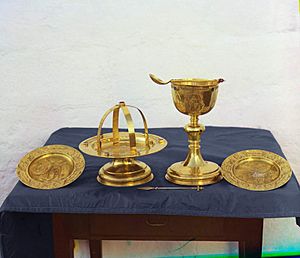Prothesis (altar) facts for kids
The Prothesis is a special area found in Orthodox and Greek-Catholic churches. It's where priests get ready for a very important service called the Divine Liturgy. The Prothesis and another area called the Diaconicon are sometimes grouped together and known as "pastophoria."
This area is usually behind the Iconostasis, which is a wall covered with religious pictures (icons). Inside the Prothesis, there's a small table often called the Table of Oblation. This is where the bread and wine are prepared before the Divine Liturgy begins. You'll often find the Prothesis on the north side of the main Altar, or sometimes it's a separate room next to the central apse (a rounded part of the church).
What is the Prothesis?

The Prothesis is a very important part of the church. It's where the priest prepares the bread and wine that will become the Body and Blood of Christ during the Divine Liturgy. This preparation is a special service called the Liturgy of Preparation.
History of the Prothesis
Long ago, the Prothesis was just a smaller table in the same room as the main Altar. It was placed against the eastern wall, to the north of the Altar.
Around the time of Emperor Justin II (who ruled from 565 to 574 AD), churches started to change. The Prothesis began to have its own separate room. This new room was on the north side of the main sanctuary and even had its own rounded section (apse). It was connected to the Altar area by an arched doorway.
At the same time, another similar room was added on the south side for the Diaconicon. Because of these changes, many large Orthodox churches from that period onward had three rounded sections (apses) at the eastern end. Smaller churches, however, often still have just one main room that includes the Altar, Prothesis, and Diaconicon all together.
Prothesis in Different Churches
In some Syriac Churches, the Prothesis is a bit different. It's usually a rectangular room, and it's where people bring their offerings. Because of this, it's sometimes placed on the south side of the church to make it easier for everyone to access.
In the Coptic Church, men can enter the Prothesis to receive Holy Communion. Women, however, receive Communion in front of the Holy Doors. Before entering the Prothesis, everyone must take off their shoes as a sign of respect.
See also
 In Spanish: Prótesis (arquitectura) para niños
In Spanish: Prótesis (arquitectura) para niños
- Altar
- Diaconicon


